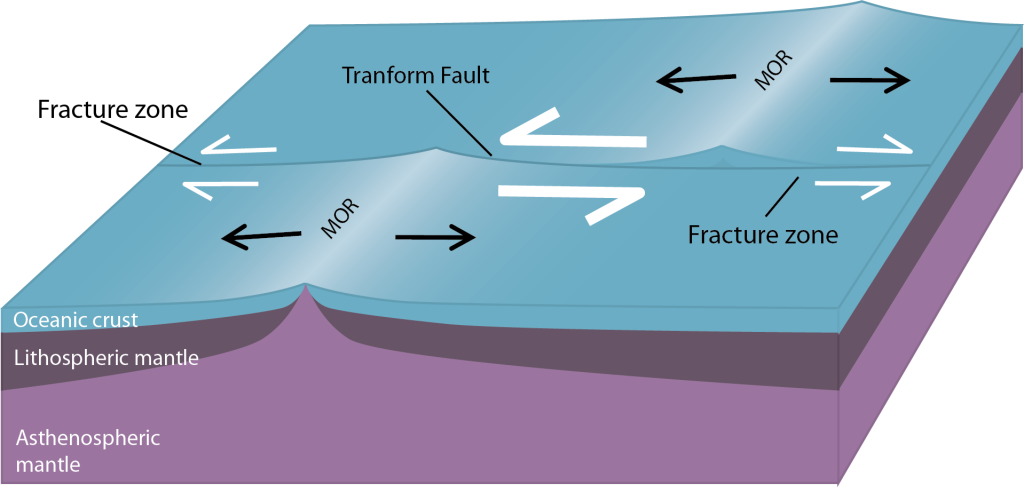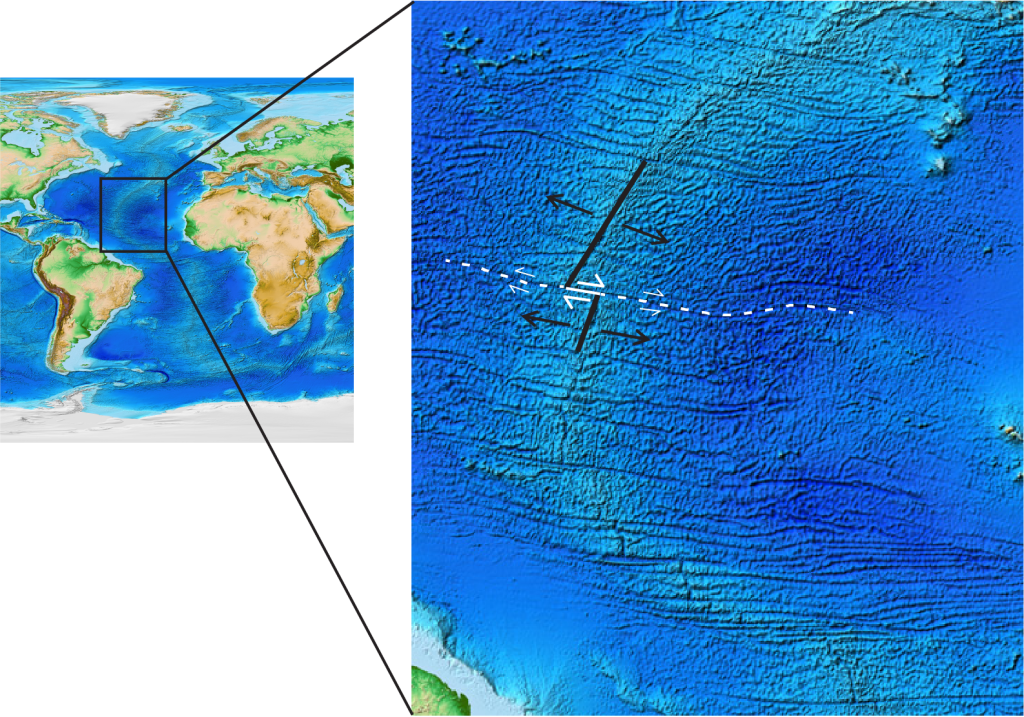5. Transform Boundaries
Transform boundaries are where two plates slide side by side past each other on the surface of the Earth, without producing or destroying crust (no divergence or convergence, respectively) (Figure 1A.5.1). The stress type here is shear – like a pair of scissor blades sliding past each other. These boundaries are also called transform faults.

Most transform boundaries tend to be relatively short segments of boundary compared to divergent and convergent boundaries. They are like “connector pieces” – they join larger segments of the other two boundary types together. Most transform faults connect segments of mid-ocean ridges and are therefore mostly ocean-ocean plate boundaries, this is seen in Figure 1A.5.2 along the Juan de Fuca Ridge and the East Pacific rise. In these areas, and along all other spreading centers, the transform faults connect offset segments of divergent boundary giving mid ocean ridges a “stair step” appearance.
Some transform faults connect continental parts of plates. The San Andreas Fault is a well know example of this. It connects the southern end of the Juan de Fuca Ridge, a mid ocean ridge in the Pacific Ocean west of the Pacific Northwest area of the USA, with the northern end of the East Pacific Rise (another mid-ocean ridge) in the Gulf of California. The part of California west of the San Andreas Fault and all of Baja California are on the Pacific Plate.
But transform faults don’t just connect divergent boundaries; it is far less common but they can also connect divergent to convergent boundaries or convergent to convergent boundaries.

Unlike divergent and convergent boundaries, when analyzing the 4 data types transform boundaries are characterized by a lack of any pattern, with the exception of earthquake activity.
5.1 Topographic Features
Transform boundaries do not have a single distinctive topographic feature like the other boundary types do. They are noticeable as a “crack” in the Earth where they connect divergent boundaries along mid-ocean ridges as seen in the enlarged segment of the Mid Atlantic Ridge in Figure 1A.5.3. On this diagram one pair of MORs is marked in black and offset by a transform boundary marked in white. There are many more examples of transform boundaries offsetting MORs in this figure. Can you find any others?
Where transform boundaries are on the continents they don’t have distinct features – they can be cutting through valley areas or cutting across mountains.

5.2 Volcanic Activity
There is no mechanism to generate magma at transform boundaries – no plates are pulling apart to allow the mantle to decompress and upwell and plates are not subducting to generate flux melting. As a result, volcanic activity is not typically present at transform boundaries themselves.
5.3 Earthquake Activity
Earthquake activity is abundant at transform boundaries. The two plates sliding past each other generate earthquakes that can be very high in magnitude. Just think of the San Andreas Fault; it is know for earthquake activity! These earthquakes are located on the boundary and are shallow (Figure 1A.5.4). Like divergent boundaries, these earthquakes are shallow because without subduction there is no lithosphere at depth.
5.4 Seafloor Age
There is not a distinct age of seafloor at transform boundaries. Ages will range from very young when they are located as the connections between divergent boundaries to no seafloor at all if they are located on the continent.
Check Your Understanding: Movement at transform boundaries
Check Your Understanding: Naming plate boundary types and features
Drag and drop the correct label to the correct spot on the diagram below to practice your understanding of Earth’s layers and plate boundaries types and features. The features to be labeled all have hints in brackets to help you interpret the diagram.
Check Your Understanding: Analyzing data to determine the plate boundary type
